The MacBook Pro Review (13 & 15-inch): 2011 Brings Sandy Bridge
by Anand Lal Shimpi, Brian Klug & Vivek Gowri on March 10, 2011 4:17 PM EST- Posted in
- Laptops
- Mac
- Apple
- Intel
- MacBook Pro
- Sandy Bridge
Improved WiFi Performance
One of the more notable changes in the 2011 MacBook Pro lineup is a completely different WiFi chipset and subsequent RF design. The previous 2010 MacBook Pro included 802.11a/b/g/n support using a BCM4322 which included full 2x2 MIMO support, meaning two spatial streams were supported. Bluetooth 3.0 was provided by a BCM2070, and the whole solution was simply a BCM954224HMB reference design.

2011 MacBook Pro WiFi+BT Module—Courtesy iFixit
Back when the new Airport Extreme (Simultaneous Dual-Band II) launched, it included one little-hyped feature. One of the most notable improvements over the previous design was inclusion of a full 3x3 radio—again 3 spatial stream support. At the time, there were no Apple products that could actually use 3 spatial streams, and as a result many assumed the feature was completely locked down.
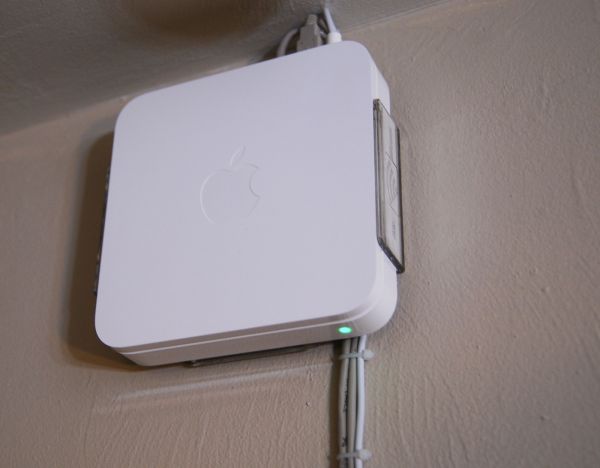
My wall-mounted Airport Extreme (Simultaneous Dual-Band II)
The Airport Extreme has had 3 spatial stream support for a long time to little fanfare. The Airport Extreme still only allows 20 MHz channels on 2.4 GHz spectrum. Other WiFi AP vendors ship firmware which will automaticaly selects 40 MHz channels on 2.4 GHz spectrum per WiFi Alliance rules, but Apple uniformly uses 20 MHz channels on 2.4 GHz. It's a design choice Apple made a while ago which still exists to this day – for two reasons. The first is that it prevents you from being, well, less than courteous and eating up to over 80% of spectrum on the already crowded 2.4 GHz ISM band with one AP. Apple's rationale for disabling 40 MHz channel support on the 2.4 GHz spectrum (for both clients and APs) is that Bluetooth needs lots of bandwidth to hop around on, and already a wide variety of Apple desktop and notebook products come by default with Bluetooth peripherals. Maintaining a good A2DP stereo stream for example requires considerable 2.4 GHz bandwidth. Instead, if you really want 40 MHz channels Apple recommends using 5 GHz, which Apple clients and Apple APs both allow to work with 40 MHz channels.
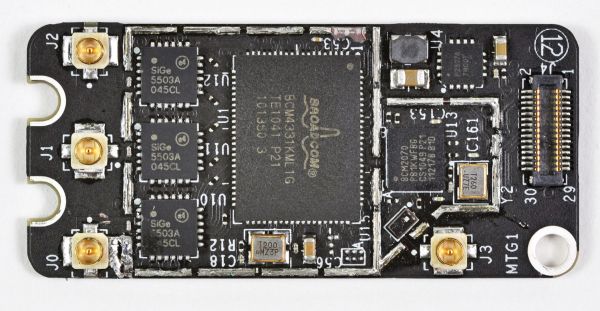
2011 MacBook Pro WiFi+BT Module—Courtesy iFixit
The 2011 MacBook Pro refresh is the first line of Apple products to bring 3x3 radios that can finally enable faster transfer rates and better performance at the edge of WiFi range. 3x3 MIMO support is starting to become relatively common in the PC notebook space, but this is the first for Apple. Inside the 2011 MacBook Pro is a BCM4331 and three clearly U.FL antenna connectors (on the left) for WiFi, as opposed to two in the previous design.
The fourth on the right is for Bluetooth, which remains 3.0 and provided by the same BCM2070 as previous models. Interestingly enough, though the Bluetooth controller is the same, the 2011 MacBook Pro includes newer firmware (37 vs 20), and software (2.4.3f1 vs 2.3.8f7). Hopefully at some point the older design will see a firmware update and bring whatever changes and improvements were made. Though the software versions are different, we couldn't detect any notable differences between the two in practice.

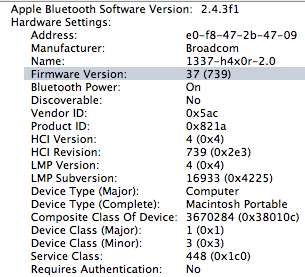
Left: 2010 MBP Bluetooth Hardware, Right: 2011 MBP Bluetooth
However, there's a dramatic improvement in both WiFi range and performance between the 2010 and 2011 refresh. With 400 ns guard intervals 40 MHz channels, 64-QAM modulation, each spatial stream adds n*150 Mbps. With 20 MHz channels, it's 72.2*n Mbps. For example, 1 spatial stream has a data rate of 150 Mbps, 2 has 300 Mbps, 3 has 450 Mbps, and so forth all the way up to 4 spatial streams and 600 Mbps as defined in the 802.11n specification. The reality of the matter is that what physical layer rate you'll see depends on the modulation and coding scheme and how many streams are going. You can look those up at any time by holding option and clicking the WiFi indicator, and looking them up in a table.
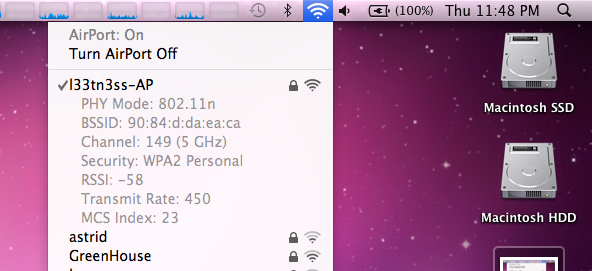
We tested a 15" 2011 MacBook Pro alongside a 15" 2010 MacBook pro connected to an Airport Extreme (Simultaneous Dual-Band II) running latest firmware. I originally suspected that 3 spatial stream support wasn't enabled, and that Apple would push a firmware update out right after their first 3 spatial stream products started shipping. Interestingly enough, it's always been there, enabled, this is just the first client I've gotten my hands on that does it. I'm not a huge fan of the Airport Extreme (I use a WRT54G-TM with Tomato and a WRT-600N with DD-WRT), but it's the only thing on hand with 3x3 MIMO. I tested in four different locations in my house—in my office, living room, kitchen, and outdoor patio. The base station is in my office mounted on the wall close to the ceiling, and those locations are subjectively ordered from best to worst.
To test, I initiated a large transfer over SMB (from a Windows Server 2008 R2 install with a 5 TB RAID5 array connected over gigabit ethernet) on each client, continually pinged AT, and at each location checked the reported transmit rate and RSSI. What we're reporting here is again the physical layer link. I'll show in a second that real-world transfers also improved, this just gives some perspective for what raw link rates are being negotiated at each location.
| WiFi Transfer Rate Differences—802.11n | ||||||||
| 2011 MacBook Pro | 2010 MacBook Pro | |||||||
| RSSI | Transfer Rate (Mbps) | RSSI | Transfer Rate (Mbps) | |||||
| Location 1—Office | -44 | 450 | -42 | 300 | ||||
| Location 2—Living Room | -61 | 130 | -64 | 117 | ||||
| Location 3—Kitchen | -69 | 117 | -68 | 78 | ||||
| Location 4—Outdoor Patio | -85 | 20 | -84 | 13 | ||||
In most cases, RSSI is within the margin of error. RSSI is generally not something you can compare, but since both wireless chipsets are Broadcom and the numbers are so close, it seems they're reported the same way and probably just dBm. Just know that generally it doesn't work that way unless you're lucky. What's important, however is that the negotiated link speed is noticeably better in essentially all locations on the new 2011 MBP. Even when the extra antenna isn't being used for a spatial stream of its own, it's actively improving link quality and helping the new MBP negotiate higher physical layer speeds.
So how much of a difference does 450 Mbps 3x3 make over 300 Mbps 2x2? With both in the exact same spot in my office, I saw throughput of 98.1 Mbps on the 2010 MBP compared to 113 Mbps on the 2011 MBP. The modest 15% improvement over the previous generation's wireless chipset isn't dramatic, instead the dramatically improved range is.
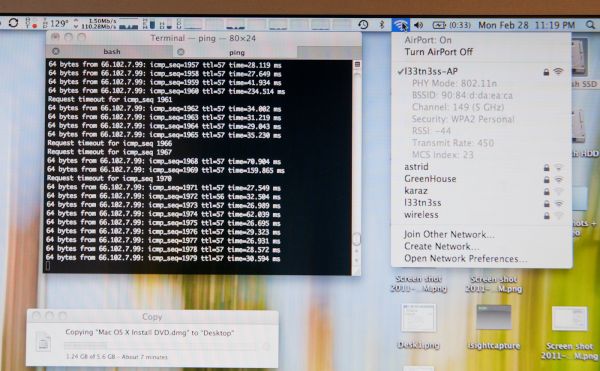 110.28 Megabits/s over WiFi. I later saw sustained 113 Megabits/s.
110.28 Megabits/s over WiFi. I later saw sustained 113 Megabits/s.
Subjectively, I found many more APs visible with the new MBP. I was able to cling onto my AP all the way out to the curb (just like smartphones) when connected on 2.4 GHz, something the old generation just couldn't do.
The only complaint I have about the new wireless chipset is that it seems to hunt around for what rate it wants negotiated. I saw a number of different MCS (modulation coding scheme) values with the 2011 MBP in the exact same place. Link rates from just below 300 Mbps all the way up to the expected 450. It seems to settle out at the expected 450 Mbps in the same room as the AP, it just takes a while, whereas other 2x2 stacks I've seen always lock onto 300 Mbps and stay there in the same room and position.










198 Comments
View All Comments
dqnet - Wednesday, March 16, 2011 - link
I'm really considering splashing out on the 13" but I've read countless articles and all I hear is the glossy screen is either horrible or awful. I don’t want the 15", I need the portability and I don’t know what on earth to do!??????????Then comes the SSD issue, if I want this option I have to wait 6 weeks!
I can always get this later down the line I guess?? Well from what the article suggests??
Any help (opinions) would be great as right now I’m lost! :(
Mac Ike - Wednesday, March 16, 2011 - link
If a person bought a MacBook Pro in the last 18-24 months,I don't see the reason to upgrade unless you're on the Bleeding-edge of performance needs and Mac your living with your Mac. Many Apps and advanced Software aren't even optimized to take advantage of multiple Cores,or Hyper-Threading/Turbo Boost. I don't care as much for Auto Switching Graphics,since I have total control of my Graphics with my March 2010 MacBook Pro 17"/Core 2 Duo/2.8 Ghz/4GB RAM/AG/500GB HD/512MB or 256(IG) VRAM-dual cards/express card. if I was buying new today,Hyper-Threading and Turbo Boost schemes would be OK,but there's no way that I'd trade or sell my machine for these updates! To me,speed hasn't been an issue in 2 or 3 years! My 2006 20" iMac was at 2.0 Ghz,and the newest Macs are 2.0-3.0Ghz or so. I know that Sandy Bridge is faster than a Merom Core Duo,but most improvements seem to have come from adding more Cores and RAM,so that more tasks can be done simultaneously! I don't care for gimmicks,Turbo-Boosting,Hyper-Threading,and poorer graphics to convince me to upgrade my Macs. Unless you are a Digital Video Content Creator,or other high-powered user,or your Mac is 3 yrs. Old or so,you should Max-out your RAM,get a faster HDD or an SSD,rather than buying a Whole New Mac! If you have the money to spend,good for you,but a combination of Power,Battery-Life,and Portability,are the REAL issues! I wish people would stop telling others that they're Idiots for paying Mac prices,since it's our Money,and only YOU can determine what's good value for the Performance,elegance,and Stability of Apple Hardware!rredge - Thursday, March 17, 2011 - link
Today, the local Apple store acknowledged that my 15" MacBook Pro is not functioning properly and refunded the purchase price despite the fact that I was just past the 14 day return period.The problem is that the computer ceased to respond to the trackpad even when rebooted with the power button.
In the course of trying to figure out what the problem was, I discovered that there are reports of people experiencing similar problems for all three models (13", 15", 17") on Apple's support forum, where one thread alone now runs 19 pages, as well as elsewhere on the internet.
The Apple store personnel told me that Apple has not acknowledged that there is a problem with this line of computers, although they acknowledged in less than two minutes that my computer has a problem sufficiently serious to warrant a refund out of the return period. I declined a replacement because they expressed ignorance of the issue, indeed said that Apple did not acknowledge an issue, and were unable to give me any assurance that a replacement would perform any better.
The questions at this point are how widespread this freezing problem is and whether Apple is going to acknowledge it and fix it.
rredge - Thursday, March 17, 2011 - link
The second paragraph should have said that the computer ceased to respond to both the trackpad and keyboard.nitrousninja - Thursday, March 17, 2011 - link
I saw the benches but I dont know if that translates into a big real world difference in SSDs. I'm mostly doing stuff in Word/Excel, some light video editing/converting, and occasionally some WoW. This would be in the base model 13"Should i go with the stock 3GB 128GB SSD or the OCZ 6GB I can get at Microcenter and install it mysel?. I've never done that on a Mac.
Thanks for the help!
Matt
tno - Wednesday, May 4, 2011 - link
Doubt you're still wondering but, if you want to have any space left after installing an OS and still want an SSD then you should splash for the 128GB SSD or wait till a reliable larger SSD is available. I wouldn't go less than 120GB.As to whether you should get an SSD, just ask yourself this question:
Have you ever sat, even for a moment, and wondered why an otherwise well specced (but magnetically driven) computer seemed slow?
If yes, then you'll likely be able to set that question aside by putting in an SSD.
tranksen76 - Friday, March 18, 2011 - link
Hello Rredge,how frustrating your experience sounds!
2011 was the year I was finally supposed to buy myself my 1st ever MBP after 18 years in the Windows environment.
It took me long enough to choose between a 13-inch or 15-inch one but then I started reading about these freeze issues a lot of users have been facing. being French i only heard about this problem within French forums and i was hoping this would have to be a specific problem for a batch of units delivered in France but now I have to admit this really is a larger scope problem.
For what it's worth there were comments on the forums I went through about I-Stats being a cause for these problems as it installs by default with a settings that take over the fans control.
Did you have that app on your computer?
Best regards
Tranksen
rredge - Friday, March 18, 2011 - link
Bonjour Tranksen,The fan on my computer was acting normally when this happened and I do not have that widget installed. I was running Terminal, TextEdit and Safari and the processor was under extremely light load.
You will find a good deal of discussion about this problem on the Apple U.S. support forum at http://discussions.apple.com/category.jspa?categor...
This is not an imaginary issue. Apple agreed to the return of my computer for full refund despite it being outside the 14 return period.
I would consider repurchasing one of these computers, but not until Apple clarifies what the problem is and fixes it.
tipoo - Saturday, March 19, 2011 - link
You said that noise was an issue with the larger MPB, but I'd like that to be quantified in decibels and compared to other laptops in a table, in future reviews.Omid.M - Monday, March 21, 2011 - link
Can the AT team comment on this please:http://apple.slashdot.org/submission/1504006/2011-...
Click on "Link to Original Source"
Can you guys duplicate this issue? Is it just simple overheating and poor design on Apple's part? I really want to know...
Also tweeted to the three of you. Thanks for your thoroughness, gang.